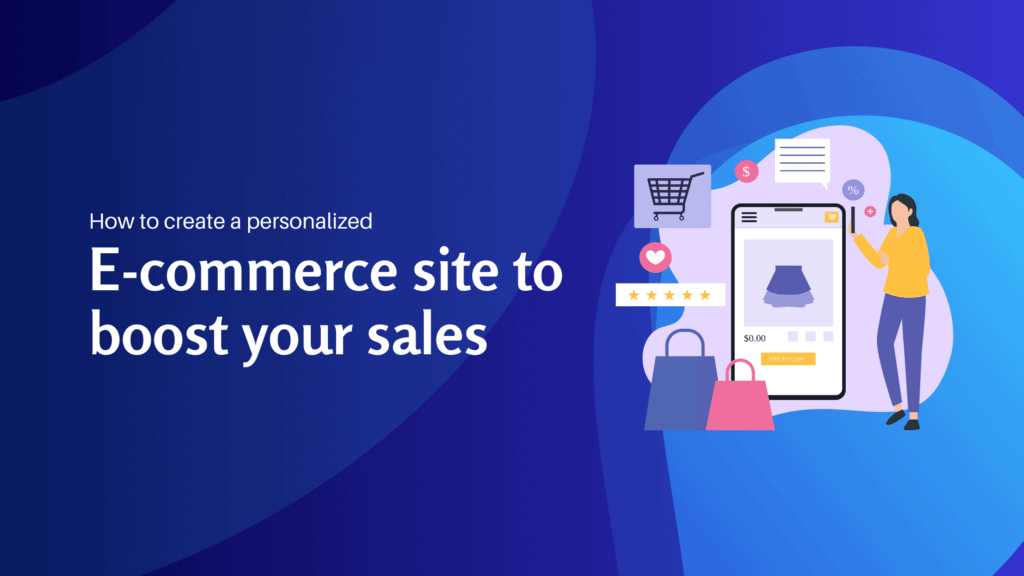Introduction
Want to increase your online sales? Then you need a customized e-commerce site that will captivate your visitors and convert them into loyal customers. In this article, we’ll show you step-by-step how to create a customized e-commerce site that will boost your sales and online visibility.
Our brand stands out for its expertise in web development and digital marketing. We’re passionate about creating websites that meet our customers’ specific needs and deliver an exceptional shopping experience for consumers.
Whether you’re new to e-commerce or looking to improve your current site, this guide will provide you with all the information you need to create a high-performance e-commerce site. We’ll guide you through every step of the way, from planning your site, to choosing the right platform and functionality, to the final launch.
Get ready to turn your site into a sales-generating machine. Follow our expert advice and discover how to create a customized e-commerce site that will help you reach new heights of online success.
The importance of a customized e-commerce site
A personalized e-commerce site is essential for increasing online sales. It offers many advantages over generic e-commerce solutions available on the market. First and foremost, a customized site allows you to create a unique brand identity and stand out from the competition. You can design a site that reflects your corporate image and matches your target audience.
What’s more, a customized e-commerce site offers superior flexibility and scalability. You can add features specific to your business and tailor them to your needs. This enables you to provide a personalized shopping experience for your customers, encouraging them to return and buy more.
Finally, a customized e-commerce site gives you total control over your online store. You can easily manage products, orders and inventory, and get a detailed view of your site’s performance. This enables you to make informed decisions to improve your sales and profitability.
Creating a customized e-commerce site requires a little more time and investment than using a generic solution, but the benefits are well worth it. You can achieve outstanding results and outperform your competitors by offering your customers a unique shopping experience.
Key features of a customized e-commerce site
To create a successful customized e-commerce site, it’s important to understand the key features you’ll need. Here are some of the essential features to consider when creating your site:

Product and category management
Product and category management is one of the basic functionalities of an e-commerce site. You need to be able to add new products quickly, organize them into logical categories and update them easily. Make sure your e-commerce platform has a user-friendly system for managing your product catalog.
Shopping cart and ordering process
A user-friendly shopping cart and simplified checkout process are essential for converting visitors into customers. Make sure your shopping cart is clear and easy to use, with features such as adding and deleting items, as well as modifying quantities. What’s more, the ordering process must be quick and simple, with clear steps for adding delivery details and choosing a payment method.
Secure payment system
The security of online transactions is crucial to earning the trust of customers. Make sure your e-commerce site offers secure payment options, such as SSL encryption and integration with reputable payment providers. This ensures that sensitive customer information is protected and payments are processed securely.
Search and filter functions
An efficient search function and advanced filtering options make it easy for customers to find products. Check that your e-commerce site offers a quick and accurate search function, as well as filters to sort products by category, price, size, color, etc. This will help customers find what they’re looking for quickly and improve their shopping experience.
Social media integration
Social media play an important role in promoting your e-commerce site. Make sure your site offers social media integration features, such as share buttons on product pages and links to your social profiles. This makes it easy for customers to share their favorite products with friends and promote your brand on social networks.
Choosing the right e-commerce platform
Choosing the right e-commerce platform is crucial to the success of your site. There are many options available, each with its own advantages and disadvantages. Here are some of the most popular e-commerce platforms:
1. WooCommerce
WooCommerce is an e-commerce extension for WordPress, the world’s most widely used content management system. It offers great flexibility and a wide range of features, making it a popular choice for e-commerce sites of all sizes. WooCommerce also boasts a vast library of plugins and themes to customize your site to your needs.
2. Shopify
Shopify is a complete e-commerce platform that lets you create your online store quickly and easily. It is renowned for its ease of use and user-friendly features. Shopify also offers secure hosting options and 24/7 support. It’s the ideal choice if you want to create your site quickly without having to worry about technical management.
3. Magento
Magento is a powerful, scalable e-commerce platform, ideal for large enterprises and complex e-commerce sites. It offers great flexibility and advanced features for managing vast product catalogs and large order flows. Magento, however, requires greater technical expertise and can be more costly to set up and maintain.
4. BigCommerce
BigCommerce is a full-featured e-commerce platform. It offers a user-friendly interface and advanced customization tools to create a unique site. BigCommerce also offers dedicated support and easy integration with popular payment providers. It’s a solid choice for small and medium-sized businesses looking for a complete solution.
The choice of e-commerce platform depends on your specific needs, budget and technical skills. Take the time to compare the different options and consult user reviews before making a decision.
Planning your customized e-commerce site
Planning is a crucial step in creating a successful personalized e-commerce site. Here are some key steps to follow when planning your site:
1. Define your objectives and target audience
Before you start building your site, it’s important to clearly define your objectives and target audience. What are your main sales objectives? Who are your potential customers? What are their needs and preferences? Answering these questions will help you design a site that meets your audience’s expectations and helps you achieve your business objectives.
2. Competitor analysis
Analyze your direct competitors to understand what’s working well in their e-commerce site and what can be improved. Examine their design, functionality, shopping experience, marketing strategies and more. This will give you ideas and insights for designing a site that stands out from the competition.
3. Create a clear site architecture
A clear site architecture is essential for smooth navigation and optimal user experience. Organize your products into logical categories and create a simple, intuitive navigation structure. Also think about the mobile experience and make sure your site is responsive and easy to use on all devices.
4. Schedule and budget
Creating a customized e-commerce site can take time and money. Plan a realistic timetable for each stage of the process, from design to launch. Also define a budget for development, hosting, marketing and other costs. This will help you stay on track and avoid overtaking.
User-friendly interface design
Designing a user-friendly interface is essential to providing your customers with a pleasant shopping experience. Here are some key principles to consider when designing your interface:
1. Use an attractive, consistent design
Attractive, consistent design is essential to attract visitors and keep them on your site. Use an attractive color palette, readable fonts and quality images to make your site professional and aesthetically pleasing. Also make sure your design is consistent across all pages to deliver a seamless experience.
2. Simplify navigation
Navigation must be simple and intuitive, so that customers can easily find the products they’re looking for. Use a clear navigation bar and logical categories to organize your products. Add a search function too, so that customers can quickly find what they’re looking for.
3. Improve loading speed
Site loading speed is crucial to delivering an optimal user experience. Optimize images, reduce scripting and use caching to speed up page loading. A fast site ensures that customers don’t get tired of waiting and stay engaged on your site.
4.use clear calls to action
Clear, visible calls to action are essential to motivate customers to take action. Use prominent buy and add-to-cart buttons, eye-catching text and incentives to action to encourage customers to buy. Make sure calls to action are consistent across all pages for a smooth user experience.
Integration of payment gateways and secure payments
The integration of payment gateways and secure payments is crucial to guaranteeing the security of online transactions. Here are some key steps for integrating secure payments on your site:
1. Choose a secure payment gateway
2. Configure payment options
Configure payment options on your site, such as credit cards, bank transfers, online payments, etc. Offer several options to suit different customers. Make sure that the checkout process is quick and easy, with clear steps for adding payment details and validating the order.
3. Test payments
Before launching your site, carry out thorough tests to ensure that payments work properly. Perform test transactions to check that payments are processed correctly and confirmations are sent to customers. Also make sure that all sensitive customer information is secure and that payment data is encrypted.
Optimizing product pages for conversions
Product page optimization is essential to encourage conversions and sales. Here are some tips for optimizing your product pages:
Use detailed, attractive descriptions
Detailed, attractive product descriptions help customers understand the features and benefits of your products. Use clear, concise, easy-to-read descriptions, with information on specifications, materials, dimensions, etc. Add high-quality images to show products from different angles.
Highlight reviews and testimonials
Customer reviews and testimonials are key to building trust with potential buyers. Highlight positive reviews and testimonials on your product pages to show that other customers are satisfied with your products. You can also add reviews and ratings to help customers make an informed purchasing decision.
Offer customization options
Customization options allow customers to tailor products to their preferences. Offer a choice of colors, sizes, patterns, etc. to meet specific customer needs. This will encourage them to buy and feel more connected to your brand.
Implementing SEO best practices for e-commerce sites
Search Engine Optimization (SEO) is essential to improve the visibility of your e-commerce site in search engines. Here are some best practices for optimizing your site for search engines:
Perform a keyword search
Perform in-depth keyword research relevant to your industry and products. Use keyword research tools such as Google Keyword Planner to find keywords with high search volume and moderate competition. Include these keywords in your titles, descriptions, title tags, etc. to improve your search engine rankings.
Optimize title tags and descriptions
Title tags and descriptions are important elements for SEO. Use clear, concise, keyword-optimized title tags to describe the content of each page. Also add attractive, informative descriptions to encourage users to click on your site in search results.
Use user-friendly URLs
User-friendly URLs are easy for users and search engines to read and understand. Use relevant keywords in your URLs and avoid long, complex URLs. User-friendly URLs help search engines understand the content of your pages and rank them more easily.
Optimize images
Image optimization is essential to improve your site’s loading speed and your search engine rankings. Reduce image size without compromising quality, and use ALT tags to describe image content. This will help search engines index your images and display them in image search results.
Monitoring and analysis of e-commerce indicators
Tracking and analyzing e-commerce metrics is essential for measuring your site’s performance and making informed decisions. Here are some key indicators to watch out for:
Conversion rates
The conversion rate measures the percentage of visitors who make a purchase on your site. Track this rate to understand how your product pages, calls to action and order process affect conversions. Identify weak points and make improvements to increase your conversion rate.
Bounce rate
The bounce rate measures the percentage of visitors who leave your site after viewing a single page. A high bounce rate may indicate problems with user experience or unappealing content. Analyze pages with a high bounce rate and make improvements to encourage visitors to explore your site further.
Sales per visitor (RPV)
Sales per visitor measures the average amount spent by each visitor to your site. Use this figure to assess the effectiveness of your sales and purchase incentive strategies. Identify the most profitable products and the most effective traffic sources to optimize your marketing and increase your RPV.
Traffic and traffic sources
Track your site’s total traffic and traffic sources to understand how users find your site. Use analytics tools such as Google Analytics to obtain detailed information on traffic channels, search keywords, marketing campaigns, etc. Use this data to optimize your marketing and increase your online visibility.
Conclusion
Creating a customized e-commerce site is an essential step towards increasing online sales and reaching new heights of success. By following the advice in this article, you can create a site that meets the specific needs of your business and offers your customers an exceptional shopping experience.
Start by defining your objectives and target audience, then choose the e-commerce platform best suited to your needs. Plan your site carefully, taking into account architecture, design and key functionalities. Implement secure payments, optimize your product pages for conversions and apply SEO best practices.
Finally, track and analyze e-commerce metrics to measure your site’s performance and make informed decisions. Identify weak points and make continuous improvements to maximize your online sales.





